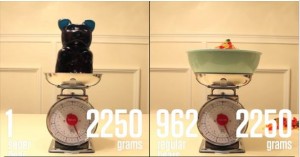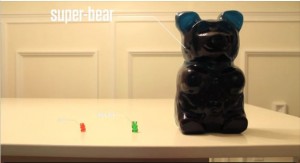How many regular size gummy bears would it take to equal one Super Bear? How about mini bears?
Students explore concepts of proportions and rates as they determine the relationships between three different sizes of gummy bears. The lesson uses a series of short multimedia videos that provide small amounts of information in a real-world problem to create intrigue. Specifically, the first video shows someone placing three different sizes of gummy bears on a table: a “mini” bear, a “regular” bear, and a “super” bear. The video ends with the three bears aligned in a row, without posing a question or providing information. The video inspires students to solve a problem by formulating their own instinctive questions and seeking out missing information.
Throughout the lesson, students guide their own learning by deciding how to solve the problem and what information they will need to do so. Working in groups, students will arrive at a solution and then share their process with the rest of the class. Students may be given guiding questions or ideas if they seem lost, but the lesson should rely on students’ abilities to discover and problem solve within groups. Once each group has shared their own ways of solving the problem, the teacher will show the whole class a new method for finding the answer using ratios and proportions. The lesson provides several opportunities for extension, including solving for both mini and regular size bears, as well as determining which option of bear provides the most gummy for the least amount of money. The lesson meets CCSS.MATH.CONTENT.6.RP.A.3, MP.1, and MP.4 in the Common Core State Standards.

Find the videos for the lesson here.
Follow our lesson plan here: Super Bear Modeling Lesson
By Brittany Stevens, Devyn Hunter, Kelly Yingling, and Enrique Gudino
